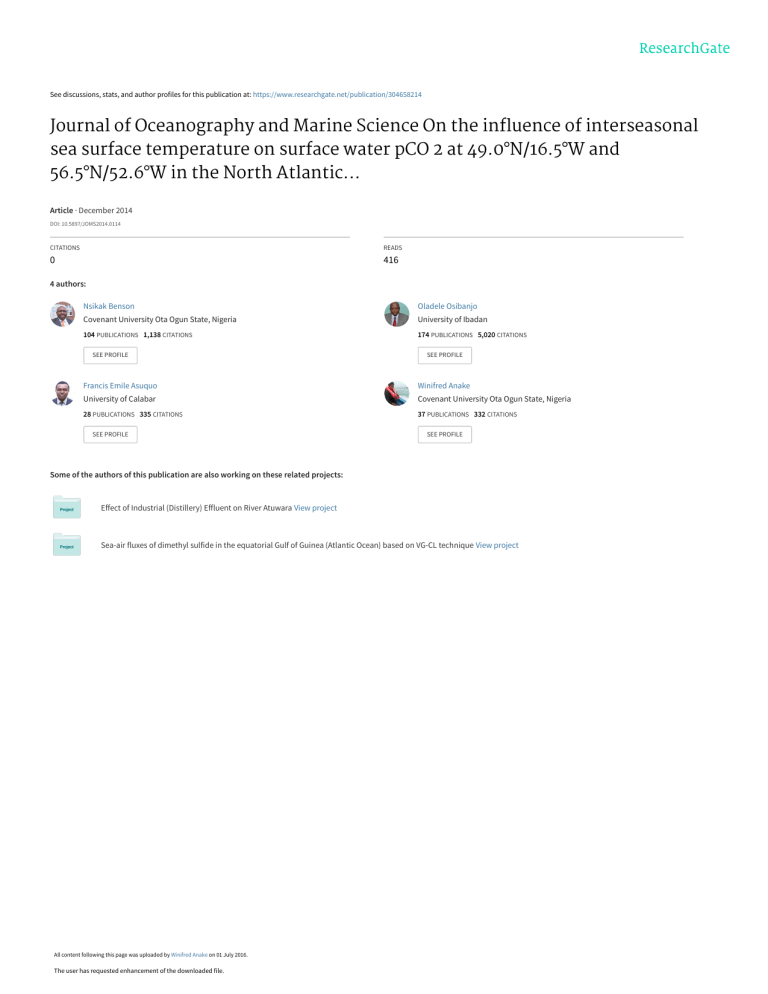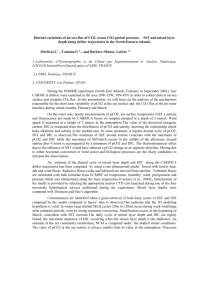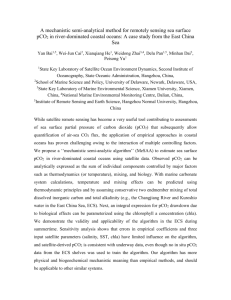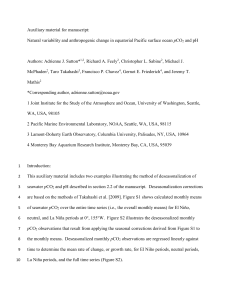
See discussions, stats, and author profiles for this publication at: https://www.researchgate.net/publication/304658214 Journal of Oceanography and Marine Science On the influence of interseasonal sea surface temperature on surface water pCO 2 at 49.0°N/16.5°W and 56.5°N/52.6°W in the North Atlantic... Article · December 2014 DOI: 10.5897/JOMS2014.0114 CITATIONS READS 0 416 4 authors: Nsikak Benson Oladele Osibanjo Covenant University Ota Ogun State, Nigeria University of Ibadan 104 PUBLICATIONS 1,138 CITATIONS 174 PUBLICATIONS 5,020 CITATIONS SEE PROFILE SEE PROFILE Francis Emile Asuquo Winifred Anake University of Calabar Covenant University Ota Ogun State, Nigeria 28 PUBLICATIONS 335 CITATIONS 37 PUBLICATIONS 332 CITATIONS SEE PROFILE SEE PROFILE Some of the authors of this publication are also working on these related projects: Effect of Industrial (Distillery) Effluent on River Atuwara View project Sea-air fluxes of dimethyl sulfide in the equatorial Gulf of Guinea (Atlantic Ocean) based on VG-CL technique View project All content following this page was uploaded by Winifred Anake on 01 July 2016. The user has requested enhancement of the downloaded file. Vol. 5(7), pp. 55-63, November, 2014 DOI : 10.5897/JOMS2014.0114 Article Number: 7008B6F48536 ISSN 2141-2294 Copyright © 2014 Author(s) retain the copyright of this article http://www.academicjournals.org/JOMS Journal of Oceanography and Marine Science Full Length Research Paper On the influence of interseasonal sea surface temperature on surface water pCO2 at 49.0°N/16.5°W and 56.5°N/52.6°W in the North Atlantic Ocean Nsikak U. Benson1*, Oladele O. Osibanjo2, Francis E. Asuquo3 and Winifred U. Anake1 1 Department of Chemistry, School of Natural and Applied Sciences, Covenant University, Ota, Ogun State, Nigeria. 2 Department of Chemistry, University of Ibadan, Ibadan, Oyo State, Nigeria. 3 Institute of Oceanography, University of Calabar, P. M. B. 1115, Calabar, Cross River State, Nigeria. Received 19 July, 2014; Accepted 29 October, 2014 The sea surface temperature (SST) and partial pressure of carbon dioxide (pCO2) derived from hourly in situ measurements at Northwest (56.5°N, 52.6°W) and Northeast (49.0°N, 16.5°W) subpolar sites of the Atlantic Ocean from 2003 – 2005 were employed to investigate the seasonal pCO2–SST relationship. The results indicate weak to moderately strong significant negative relationships (r = -0.04 to -0.89, p<0.0001) and (r = -0.56 to -0.97, p<0.0001) between SST and pCO2 for the Northeast and Northwest observed data respectively. At the Northwestern site, the variation in surface water pCO2 might be partly controlled by the seasonal change in SST as well as biological activities and other physical processes. The variability in pCO2 distribution at the Northeastern oceanographic site were attributed principally to mixing and stratification processes during the autumn and spring seasons, while the pCO2–SST interrelationship obtained during summertime suggested that pCO2 variability could have been induced mainly by thermodynamic effects. Key words: Sea surface temperature, pCO2, temperature effects, temperature anomalies, North Atlantic Ocean. INTRODUCTION Carbon dioxide (CO2) dominance in the atmosphere (mainly from anthropogenic sources) over other greenhouse gases has resulted in increasing pCO2 in the surface ocean leading to measurably decreased pH (ocean acidification) (Canadell et al., 2007; Hopkins et al., 2010; Keeling and Whorf, 2005; Levine et al., 2008; Sabine and Feely, 2007). The world oceans are major natural sinks of atmospheric CO2. However, the North Atlantic Ocean is generally regarded as a primary gate for CO2 entering the global ocean due to its subpolar climate. In the open ocean, it has been established that significant correlation exists between surface water pCO2 and sea surface temperature (SST). However, the sea surface pCO2–SST relationships are primarily governed by a combination of processes, such as biological activity, physical transport-upwelling of nutrients, and thermodynamics (e.g. temperature effects on CO2 dissociation and solubility) (Körtzinger et al., 2008a, b; Chen et al., 2007). Takahashi et al. (2002, 2009) have elucidated the mechanism and the role of thermodynamic effects on the uptake of CO2 by the global oceans. Recently, several studies have reported the low uptake of pCO2 in the North Atlantic Ocean suggesting a gradual weakening of an active carbon storehouse (Corbière et *Corresponding author. E-mail: nbenson@covenantuniversity.edu.ng Author(s) agree that this article remain permanently open access under the terms of the Creative Commons Attribution License 4.0 International License 56 J. Oceanogr. Mar. Sci. Figure 1. Map of the North Atlantic Ocean showing the Porcupine Abyssal Plain (49.0oN, 16.5oW) and Labrador Sea (56.5°N, 52.5°W) mooring sites. al., 2007; Omar and Olsen, 2006; Schuster and Watson, 2007; Schuster et al., 2009; Ullman et al., 2009). The phenomenal CO2 low uptake is due to several factors including rising sea surface temperatures (Corbière et al., 2007), deep convection and re-stratification periods (Körtzinger et al., 2008a, b; Straneo, 2006) and variations in biological productivity (Behrenfeld et al., 2006; Lefèvre et al., 2004). The role of temperature-controlled and biological processes in regulating ocean pCO2 have been intensively investigated and reported (Feely et al., 2002; Friederich et al., 2008; Körtzinger et al., 2008a; Takahashi et al., 1993; 2002; Watson et al., 1991). According to Shim et al. (2007), the temporal change in surface water temperature could be a major factor that drives a seasonal variation in surface pCO2. However, thermodynamic effect is caused by the dependence of CO2 solubility and dissociation constants on temperature (Rangama et al., 2005). Many global biogeochemical cycles (notably CO2 and CH4 cycles), mediated by biological processes are highly dependent on temperature. The solubility of CO2 and the dissociation of carbonic acid in seawater are moderated by temperature. It has been established that as temperature decreases the solubility of gases increases; this infers greater gas solubility for seawater in high latitudes. In this paper, observed data from two North Atlantic time series sites are employed in an attempt to assess the interseasonal sea surface temperature variations and anomalies at the eastern and western basins of the North Atlantic Ocean, and examine its effect on seasonal pCO2 distribution at these sites. Description of mooring stations The Porcupine Abyssal Plain (PAP) observatory (Figure 1), located in the Northeast Atlantic oceanographic region is a major long-term ocean observatory operated since 1989 for international and interdisciplinary scientific research and monitoring, which are focused on physicalbiogeochemical observations. It is approximately 4800 m deep and is geographically positioned between the North Atlantic Current (NAC) and Azores Current (AC), and lies south of the main stream of the NAC, where it is subject to return flows from the West and Northwest. It is also characterized by significant presence of mesoscale eddies and deep winter mixing with strong interannual variability between 300 and 800 m (Longhurst, 2007). On the other hand, the K1 Central Labrador Sea (K1 CELAS) mooring site (Figure 1) is a deep-water formation oceanographic site of research importance that examines complex oceanic processes from surface waters to the seafloor by recording biological, chemical and physical parameters, as well as investigations of trends and variability in deep convection activity (Avsic et al., 2006). METHODS AND DATA ANALYSIS Detailed sampling and analytical procedures for SST and pCO2 data generation at the KI CELAS and PAP observatories have been Benson et al. 57 Table 1. SST and pCO2 measurements, depths and time intervals at PAP and K1 CELAS stations. Parameter Dissolved carbon dioxide Temperature Depths measured (m) 30, 40, 60, 75, 90, 110, 130, 150 0, 250, 300, 1000 Sensor employed Sunburst SAMI MicroCat Sampling interval 1 h (PAP2 and K1), 2 h (PAP3, PAP4) 15 min (PAP2, PAP3, PAP4), 12 h (K1) Table 2. Geographical coordinates of PAP and K1 CELAS observatory mooring stations. Mooring identifier Mooring coordinates Deployment cruise / date Recovery cruise / date Duration (days) Total number of measurements 49.0°N 16.5°W RV Poseidon 300 / 13-Jul-2003 RV Poseidon 306 / 03Nov-2003 113 2679 PAP-3 49.0°N 16.5°W Poseidon 306 / 18-Nov-2003 RSS-Charles Darwin 158 / 20-Jun-2004 213 2519 PAP-4 49.0°N 16.5°W RSS Charles Darwin 158 / 23Jun-2004 RSS Discovery 295 / 18-March-2005 267 6353 K1 CELAS 56.5°N, 52.5°W 15-Sept -2004 21-July-2005 310 7404 Tem perature (°C) PAP-2 Figure 2. Monthly variation pCO2 and SST at PAP and K1 CELAS observatories Atmospheric CO2 (cyan) is obtained from Mauna, Loa. reported previously (Körtzinger et al., 2008a, b). These involved measurements of pCO2 with an autonomous sensor (SAMI-CO2, Sunburst Sensors LLC, Missoula, Montana, United States), while temperature measurements were carried out with an SBE-37 MicroCAT recorder (Sea-Bird Electronics Inc., Bellevue, Washington, United States). The data used in this study were obtained during three consecutive deployments between July 2003 and July 2005 for the PAP and K1 CELAS mooring stations. Details of mooring coordinates, nominal depth of deployment of sensors used, sampling interval, deployment and recovery dates, parameters measured and the total number of observational data successfully recovered are presented in Tables 1 and 2. RESULTS AND DISCUSSION Distribution of surface water pCO2 and SST The distributions of sea surface temperature and pCO2 for the PAP-2 to PAP-4 deployments at the PAP and K1 CELAS time series observatories together with the atmospheric CO2 are shown in Figure 2. The pCO2 distribution across the spatial gradients at both the eastern (PAP) and western (K1 CELAS) sites of the 58 J. Oceanogr. Mar. Sci (A) (B) (C) SST Anomaly (°C) Figure 3. (a) Monthly SST anomalies (°C) at the K1 Central Labrador Sea (CELAS) and Porcupine Abyssal Plain (PAP) sites between July 2003 – July 2005, (b) Monthly anomalies of pCO2 against SST monthly anomalies at the PAP site for fall/winter period (transparent red triangles) and the spring/summer period (black triangles), (c) Monthly anomalies of pCO2 against SST at the K1 CELAS site for the fall/winter period (transparent red triangles) and spring/summer period (red riangles). subpolar North Atlantic Ocean showed distinct and consistent seasonal variability. The surface water pCO2 cycle is characteristically marked by a minimum and maximum pCO2 distribution pattern for the summertime and wintertime, respectively. It is also well depicted in Figure 2 that the pCO2 distribution patterns at both oceanographic sites are in antiphase to the temperature signal. SST anomalies The PAP and K1 CELAS monthly anomalies of SST derived as a difference between monthly averages and the long-term mean temperatures of each oceanographic station are presented here. Negative SST anomalies (>2.5°C) were generally observed during late fall through the wintertime into springtime, whereas positive SST anomalies (<3.2°C) characterized the summertime at all the PAP sites (Figure 3a). A similar trend was observed for the K1 Central Labrador Sea data although with a relatively smaller but significant negative SST anomaly of approximately 1.36°C and high SST positive anomaly of 3.6°C (Figure 3a). A comparison of the monthly anomalies of observed pCO2 with respect to SST anomalies at both sites are Benson et al. shown in Figure 3b and c. For pCO2 anomalies calculated based on average monthly observations at the PAP and K1 CELAS sites indicate positive anomalies of approximately 38 and 25 µatm respectively. These positive deviations coincided with the highest SST positive anomaly obtained for the PAP observations during spring/summer period (black triangles) Figure 3b, while it corresponded with the lowest SST negative anomaly for the K1 CELAS observed data during fall/winter period (transparent red triangles) Figure 3c. This implies that a positive pCO2–SST relationship exists for the observed data obtained from the PAP time series site, while an inverse correlation may be established for K1 CELAS site. However, it should be noted that the pCO2–SST anomalies comparison did not suggest a clear and consistent relationship especially for the PAP location. For instance, positive pCO2 deviations derived for summer and early fall of 2003 (July – October) coincided with positive SST anomalies, whereas the SST anomalies indicated an opposite behavior with marked negative pCO2 anomalies during the same period in 2004 (corresponding to 3rd PAP deployment) (Figure 3b). This variation might be attributed to thermodynamic effect or other physical processes such as mixing and stratification that might have resulted in negative pCO2 anomalies with corresponding positive SST anomalies. Moreover, for the winter / springtime, positive pCO2 anomalies at the PAP site are generally associated with significant negative SST anomalies which suggest biologically driven pCO2 variability. Negative SST anomalies are usually associated with enhanced nutrient and dissolved inorganic carbon (DIC) inputs, which could invariably lead to increase in primary productivity (Borges et al., 2007; Boyd et al., 2001). Dependence of surface water pCO2 on temperature Correlation between pCO2 and SST The Pearson correlation analysis were carried out to establish the inter-annual / inter-seasonal relationships between observed pCO2 and SST data obtained from the PAP and K1 CELAS sites. More so, given the large number of data, the interseasonal test of linear fits between pCO2 and SST were evaluated based on average monthly data collated from hourly measurements. The derived linear fits generally indicated strong but negative correlations between pCO2 and SST. Correlation between pCO2 and SST at PAP site Figures 4a, b and c show the results of fitting linear model to describe the relationship of observed PAP site pCO2 as a function of sea surface temperature for the second (PAP2), third (PAP3), and forth (PAP4) deployments on an annual timescale. 59 A better mechanistic understanding of how changes in SST and other processes may have influenced sea surface pCO2 was evaluated using seasonal observed data during each deployment. Sea surface pCO2–SST correlations generally showed negative correlations between these two variables (r2 = 25.85, 74.13, 5.75, p < 0.0001) (Figures 4a to c) at the PAP site suggesting that SST had a non-dominance influence on pCO2 variability. This also suggests that a large part of the observed variation may be attributed to non thermal processes such as the enhanced biological activity associated with physical transport – upwelling of nutrient enriched water into the euphotic zone, mixing or stratification. This argument is supported by the derived pCO2–SST correlations for summer – fall 2003 observed data that characteristically indicated a strong influence of SST on pCO2 variability (Table 3). It should be noted however, that changes in sea surface temperature principally influenced the surface water pCO2 cycle at the PAP site during deployments in 2004 to 2005, with insignificant biological effect except during wintertime. In general, the correlations between temperature and pCO2 based on observed data suggest that pCO2 seawater patterns in the Northeast subpolar Atlantic Ocean is due to the counteracting effects of temperature, mixing and strong to moderate biological production. This observation is consistent with earlier reports by Körtzinger et al. (2008a) and Takahashi et al. (2002, 2009). Inter-relationship between pCO2 and SST at Labrador sea site Figure 5a and b illustrate the relationships of pCO2 as a function of SST during the period. A closer inspection of the derived linear fits reveal that the sea surface pCO2– SST correlations were characteristically more variable and generally depicted the irrefutable effect of temperature and biology on pCO2, although it is clear that the pCO2 cycle is strongly governed by thermodynamic forcing than biological effect. The pCO2–SST correlation obtained for observed data during the deployment in 2004 indicated that there is a good linear relationship between sea surface pCO2 and in-situ SST (Table 3). A similar relationship was found for sea surface pCO2– SST correlations obtained for 2005 K1 deployment, but with a moderately strong relationship (r2 = 0.53, p<0.0000) (Figure 5b). On an annual to seasonal timescale, the distribution pattern in surface seawater pCO2 might not be controlled by a seasonal change in temperature only but also by biology as well as mixing within the subsurface and stratification of the epipelagic zone of the K1 CELAS site (Körtzinger et al., 2008b). However, it is obvious that the thermodynamic effects and other physical processes are the dominating variability driver compared to weak biology signature at J. Oceanogr. Mar. Sci 450 (A) pCO2 µatm = 470.002 - 7.685*Temp R2 = 25.85 pPCO CO2µ tm µatm 2a 420 390 360 330 300 12 13 14 15 Temp. Temperature (°C)oC 16 17 18 370 (B) PCO µatm pCO 2 atm 2µ 350 pCO2 µatm = 436.542 - 8.051*Temp R2 = 74.13 330 310 290 270 11 13 15 Temp °C (°C) Temperature 17 19 390 p CO 22µa tm PCO µatm 60 pCO2= 458.71 - 8.32*Temp R2 = 5.75 (C) 380 370 360 350 340 11.9 12.1 12.3 12.5 Temp °C Temperature (°C) 12.7 12.9 Figure 4. Distributions of pCO2 as a function of SST during PAP2 (a), PAP3, (b) and PAP4 (c) deployments. Table 3. PAP and K1 CELAS seasonal pCO2 distributions as a function of SST. Time series location PAP Season Summer (July-August) 2003 Fall 2003 Winter 2004 Spring 2004 Summer 2004 Fall 2004 Winter 2005 March (Early Spring) 2005 K1 CELAS Fall 2004 Winter 2005 Spring 2005 Summer (July-August) 2005 Correlation equation for pCO2 (µatm)/SST (oC) pCO2 = -23.49×SST + 645.54 pCO2 = -7.09 × SST + 427.26 pCO2 = -11.88 × SST + 469.58 pCO2 = -24.97 × SST + 615.49 pCO2 = -12.30 × SST + 430.95 pCO2 = -8.52 × SST + 374.36 pCO2 = -26.65 × SST + 616.52 pCO2 = -1.65× SST + 308.19 Correlation Coefficient (r) Coefficient of determination (R2) % -0.80 -0.66 -0.72 -0.60 -0.87 -0.89 -0.85 64.28 43.48 51.29 35.45 75.37 79.49 71.69 -0.04 0.16 pCO2 = -9.65×SST + 395.45 pCO2 = -27.00×SST + 462.18 pCO2 = -49.69×SST + 543.54 pCO2 = -11.54×SST + 399.29 -0.97 -0.81 -0.87 -0.56 93.87 65.27 75.74 31.18 Benson et al. 61 360 (A) pCO2 = 389.215 - 8.870*Temp R2 = 0.95 pCO2P C microatm O 2 µ a tm 350 340 330 320 310 300 3.6 4.6 5.6 6.6 7.6 Temp (oC) Temperature (°C) 8.6 9.6 400 (B) P Cmicroatm O 2 µ a tm pCO2 380 pCO2 = 428.605 - 17.301*Temp R2 = 0.53 360 340 320 300 280 3.1 4.1 5.1 Temp (oC) Temperature (°C) 6.1 7.1 Figure 5. Distributions of pCO2 as a function of SST at the Northwest Labrador Sea in 2004 (a), and 2005 (b) K1 deployments. this subpolar NW Atlantic site. A comparison of the seasonal sea surface pCO2–SST correlations at the K1 CELAS site also reveal significant but negative correlations between these two parameters during autumn 2004 and spring 2005. This implies that other physical processes such as turbulence, mixing and stratification primarily govern the variability in pCO2 distribution. On the other hand, the pCO2–SST correlation obtained for summer 2005 indicates a positively significant correlation implying that mainly thermodynamic effects induce pCO2 variability. A summary of pCO2–SST relationships at both the Northeast and Northwest sites of the Atlantic Ocean is presented in Table 3. CONCLUDING REMARKS This study has demonstrated that the surface water pCO2 distribution across the spatial gradients over a seasonal timescale at both the eastern (PAP) and western (K1 CELAS) basins of the subpolar North Atlantic Ocean is relatively consistent, however with distinct seasonal large variability. At the PAP site, consistent undersaturation of oceanic surface water was observed relative to the atmospheric CO2, while a similar trend occurred over the western area at the K1 CELAS location but with some degree of supersaturation between February and March 2005. On a seasonal timescale, the surface water pCO2 cycle is characteristically marked by minimum and maximum pCO2 distribution pattern for the summertime and wintertime respectively. It is obvious that the pCO2 distribution pattern in the NE PAP and NW CELAS sites of the subpolar North Atlantic were in antiphase to the temperature signal. Investigation of sea surface pCO2– SST correlations generally indicated moderate to strong but negative correlations between pCO2 and SST. Thus we conclude that the variation in surface ocean pCO2 62 J. Oceanogr. Mar. Sci may not be controlled by change in sea surface temperature only, but by biological activities and other physical processes. In the Northeastern basin, the variability in pCO2 distribution is primarily governed by other physical processes such as mixing and stratification during the autumn and springtime, while the pCO2–SST relationship obtained for summertime indicates that pCO2 variability is induced mainly by thermodynamic effects. Conflict of Interest The authors have not declared any conflict of interest. ACKNOWLEDGEMENTS The EuroSITES Project data was used for this research, contributions of the principal investigator and other scientists involved in the PAP project are acknowledged. The first author is particularly thankful to Professors G. A. McKinley and Arne Körtzinger for technical guidance. The fellowship opportunity provided by the Fulbright Scholarship Program to the Department of Atmospheric, Space and Ocean Sciences, University of Wisconsin, Madison is acknowledged. The authors would like to thank anonymous reviewers for their comments and suggestions made to improve the original manuscript. REFERENCES Avsic T, Karstensen J, Send U, Fischer J (2006). Interannual variability of newly formed Labrador Sea Water from 1994 to 2005. Geophys. Res. Lett. 33:L21S02. doi:10.1029/2006GL026913. http://dx.doi.org/10.1029/2006GL026913 Behrenfeld MJ, O'Malley RT, Siegel DA, McClain CR, Sarmiento JL, Feldman GC, Milligan AJ, Falkowski PG, Letelier RM, Boss ES (2006). Climate-driven trends in contemporary ocean productivity. Nature 444:752-755. Borges AV, Tilbrook B, Metzl N, Lenton A, Delille B (2007). Inter-annual variability of the carbon dioxide oceanic sink south of Tasmania. Biogeosciences Discuss. 4:3639-3671. Boyd PW, Crossley AC, DiTullio GR, Griffiths FB, Hutchins DA, Queguiner B, Sedwick PN, Trull TW (2001). Control of phytoplankton growth by iron supply and irradiance in the subantarctic Southern Ocean: Experimental results from the SAZ Project. J. Geophys. Res. 106(C12)31:573-583. Canadell JG, Le Que´re´ C, Raupach MR, Field CB, Buitenhuis ET, Ciais P, Conway TJ, Gillett NP, Houghton RA, Marland G (2007). Contributions to accelerating atmospheric CO2 growth from economic activity, carbon intensity, and efficiency of natural sinks. Proc. Natl. Acad. Sci. 104(47):18866-18870, doi:10.1073/pnas.0702737104, http://dx.doi.org/10.1073/pnas.0702737104 Corbière A, Metzl N, Reverdin G, Brunet C, Takahashi T (2007). Interannual and decadal variability of the oceanic carbon sink in the North Atlantic subpolar gyre. Tellus 59B(2):168-178. Chen F, Cai W-J, Benitez-Nelson C, Wang Y (2007). Sea surface pCO2-SST relationships across a cold-core cyclonic eddy: Implications for understanding regional variability and air-sea gas exchange. Geophys. Res. Lett. 34:L10603, doi:10.1029/2006GL028058. http://dx.doi.org/10.1029/2006GL028058 Feely RA, Boutin J, Cosca CE, Dandonneau Y, Etcheto J, Inoue HY, Ishii M, Le Quéré C, Mackey DJ, McPhaden M, Metzl N, Poisson A, Wanninkhof R (2002). Seasonal and interannual variability of CO2 in the equatorial Pacific. Deep Sea Res. Part II: Top. Stud. Oceanogr. 49(13-14):2443-2469. Friederich GE, Ledesma J, Ulloa O, Chavez FP (2008). Air-sea carbon dioxide fluxes in the coastal southeastern tropical Pacific. Prog. Oceanogr. 79:156-166, doi.10.1016/j.pocean.2008.10.001 Hopkins FE, Turner SM, Nightingale PD, Steinke M, Bakker D, Liss PS (2010). Ocean acidification and marine trace gas emissions. Proc. Natl. Acad. Sci. 107(2):760-765, doi:10.1073/pnas.0907163107, http://dx.doi.org/10.1073/pnas.0907163107 Keeling CD, Whorf TP (2005). Atmospheric CO2 records from sites in the SIO air sampling network. In Trends: A Compendium of Data on Global Change. Carbon Dioxide Information Analysis Center, Oak Ridge National Laboratory, U.S. Department of Energy, Oak Ridge, Tenn., U.S.A. Körtzinger A, Send U, Lampitt RS, Hartman S, Wallace DWR, Karstensen J, Villagarcia MG, Llinas O, DeGrandpre MD (2008a). Seasonal pCO2 cycle at 49°N / 16.5°W in the northeast Atlantic Ocean and what it tells us about biological productivity. J. Geophys. Res.113, C04020, doi:10.1029/2007JC004347. http://dx.doi.org/10.1029/2007JC004347 Körtzinger A, Send U, Wallace DWR, Kartensen J, DeGrandpre M (2008b). Seasonal cycle of O2 and pCO2 in the central Labrador Sea: Atmospheric, biological, and physical implications. Global Biogeochem. Cycles 22, GB1014, doi:10.1029/2007 GB003029. Lefèvre N, Watson AJ, Olsen A, Ríos AF, Pérez FF, Johannessen T (2004). A decrease in the sink for atmospheric CO2 in the North Atlantic. Geophys. Res. Lett. 31:L07306, doi:10.1029/2003GL018957. http://dx.doi.org/10.1029/2003GL018957 Levine NM, Doney SC, Wanninkhof R, Lindsay K, Fung IY (2008). Impact of ocean carbon system variability on the detection of temporal increases in anthropogenic CO2. J. Geophys. Res. 113:C03019, doi:10.1029/2007JC004153. http://dx.doi.org/10.1029/2007JC004153 Longhurst AR (2007). Ecological Geography of the Sea, 2nd ed., 542 pp. Academic, Boston, Mass. Omar AM, Olsen A (2006). Reconstructing the time history of the airsea CO2 disequilibrium and its rate of change in the eastern subpolar North Atlantic, 1972-1989. Geophys. Res. Lett. 33:L04602, doi:10.1029/2005GL025425, http://dx.doi.org/10.1029/2005GL025425 Rangama Y, Boutin J, Etcheto J, Merlivat L, Takahashi T, Delille B, Frankignoulle M, Bakker DCE (2005). Variability of the net air-sea CO2 flux inferred from shipboard and satellite measurements in the Southern Ocean of Tasmania and New Zealand. J. Geophys. Res. 110, C09005, doi:10.1029/2004JC002619, http://dx.doi.org/10.1029/2004JC002619 Sabine CL, Feely RA (2007). The Oceanic Sink for Carbon Dioxide, in: Reay, D.S., Hewitt, C.N., Smith, K.A., Grace, J. (Eds), Greenhouse Gas Sinks. Athenaeum Press Ltd, Gateshead, UK. Schuster U, Watson AJ (2007). A variable and decreasing sink for atmospheric CO2 in the North Atlantic. J. Geophys. Res. 112:C11006, doi:10.1029/2006JC003941, http://dx.doi.org/10.1029/2006JC003941 Schuster U, Watson AJ, Bates NR, Corbiere A, Gonzalez-Davila M, Metzl N, Pierrot D, Santana-Casiano M (2009). Trends in North Atlantic sea-surface fCO2 from 1990 to 2006. Deep-Sea Res. II, doi:10.1016/j.dsr2.2008.12.011, http://dx.doi.org/10.1016/j.dsr2.2008.12.011 Shim J, Kim D, Kang YC, Lee JH, Jang S-T, Kim C-H (2007). Seasonal variations in pCO2 and its controlling factors in surface seawater of the northern East China Sea. Cont. Shelf Res. 27:2623-2636, doi:10.1016/j.csr.2007.07.005, http://dx.doi.org/10.1016/j.csr.2007.07.005 Straneo F (2006). Heat and Freshwater Transport through the Central Labrador Sea. J. Phys. Oceanogr. 36(4):606-628. doi: 10.1175/JPO2875.1, http://dx.doi.org/10.1175/JPO2875.1 Benson et al. Takahashi T, Olafsson J, Goddard J, Chipman DW, Sutherland SC (1993). Seasonal variation of CO2 and nutrients in the high-latitude surface oceans: A comparative study. Global Biogeochem. Cycles 7: 843-878. Takahashi T, Sutherland SC, Sweeney C, Poisson A, Metzl N, Tilbrook B, Bates N, Wanninkhof R, Feely RA, Sabine C, Olafsson J, Nojiri Y (2002). Global sea to air CO2 flux based on climatological surface ocean pCO2, and seasonal biological and temperature effects. Deep Sea Res. Part II: Top. Stud. Oceanogr. 49:1601-1622. http://dx.doi.org/10.1016/j.dsr2.2008.12.009 Takahashi T, Sutherland SC, Wanninkhof R, Sweeney C, Feely RA, Chipman DW, Hales B, Friederich G, Chavez F, Sabine C, Watson A, Bakker DCE, Schuster U, Metzl N, Inoue HY, Ishii M, Midorikawa T, Nojiri Y, Körtzinger A, Steinhoff T, Hoppema M, Olafsson J, Arnarson TS, Tilbrook B, Johannessen T, Olsen A, Bellerby R, Wong CS, Delille B, Bates NR, de Baar HJW (2009). Climatological mean and decadal change in surface ocean pCO2, and net sea–air CO2 flux over the global oceans. Deep-Sea Research II, doi:10.1016/j.dsr2.2008.12.009. View publication stats 63 Ullman D, McKinley GA, Bennington V, Dutkiewicz S (2009). Trends in the North Atlantic carbon sink: 1992-2006. Global Biogeochem. Cycles 23, GB4011, doi:10.1029/2008GB003383, http://dx.doi.org/10.1029/2008GB003383 Watson AJ, Robinson C, Robinson JE, Williams PJL, Fasham MJR (1991). Spatial variability in the sink for atmospheric carbon dioxide in the North Atlantic. Nature 350:50-53.



